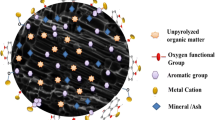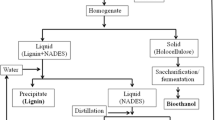Abstract
Effective pretreatment of lignocellulosic biomass is required to improve cellulose accessibility and enhance enzymatic hydrolysis. In this study, Enset fiber was subjected to different pretreatments to increase the glucose yield from enzymatic hydrolysis. Firstly, the effect of milling time, rotational speed, and milling mode in planetary ball milling were studied. Secondly, the intensification effect of combining planetary ball milling with low concentration alkaline pretreatment in sequential and simultaneous (dry chemomechanical) schemes were investigated. Following pretreatment, samples were hydrolyzed using cellulase and their crystallinity; particle size and morphology were analyzed. The result confirmed that the maximum glucose yield achieved from the dry chemomechanical method was 581 g/kg of pretreated Enset fiber, which is 86 and 22% higher compared to single alkaline and single dry ball milling pretreatments, respectively. Compared to the sequential pretreatments, the dry chemomechanical pretreatment resulted in comparable glucose yield from hydrolysis while cutting the pretreatment time from 120 to 90 min. Moreover, the energy efficiency of dry chemomechanical pretreatment was 1.3, 5.3, and 7.8 times higher than the energy efficiency of dry ball milling, sequential, and alkaline pretreatments, respectively. Therefore, the action of alkali and planetary ball milling in the dry chemomechanical pretreatment acted synergistically to intensify the pretreatment and enhance the production of glucose.









Similar content being viewed by others
References
Balat M, Balat H, Öz C (2008) Progress in bioethanol processing 34:551–573
Seidl PR, Goulart AK (2016) Pretreatment processes for lignocellulosic biomass conversion to biofuels and bioproducts. Curr Opin Green Sustain Chem 2:48–53
Walford SN (2008) Sugarcane bagasse: how easy is it to measure its constituents? Proc Annu Congr - South African Sugar Technol Assoc 81:266–273
Teli MD, Terega JM (2017) Chemical, physical and thermal characterization of Ensete ventricosum plant fibre. Int Res J Eng Technol 04:67–75
Berhanu H, Neiva D, Gominho J et al (2020) Bio-refinery potential of Enset/Ensete ventricosum/fiber bundle using noncatalyzedand alkali catalyzed hydrothermal pretreatment. Waste and Biomass Valorization 12:663–672
Yemata G (2020) Ensete ventricosum: a multipurpose crop against hunger in Ethiopia. Sci World J 2020:1–10
Berhanu H, Kiflie Z, Miranda I et al (2018) Characterization of crop residues from false banana /Ensete ventricosum/ in Ethiopia in view of a full-resource valorization. PLoS ONE 13:1–21
Borrell JS, Biswas MK, Goodwin M et al (2019) Enset in Ethiopia: a poorly characterized but resilient starch staple. Ann Bot 123:747–766
Ruth D, Janssen R (2007) Bio fuel technology handbook, In WIP Renewable Energies, German, München
Subhedar PB, Gogate PR (2013) Intensification of enzymatic hydrolysis of lignocellulose using ultrasound for efficient bioethanol production: a review. Ind Eng Chem Res 52:11816–11828
Chakraborty S, Raju S, Pal RK (2014) A multiscale three-zone reactive mixing model for engineering a scale separation in enzymatic hydrolysis of cellulose. Bioresour Technol 173:140–147
Nitsos CK, Lazaridis PA, Mach-Aigner A et al (2019) Enhancing lignocellulosic biomass hydrolysis by hydrothermal pretreatment, extraction of surface lignin, wet milling and production of cellulolytic enzymes. Chemsuschem 12:1179–1195
Zakaria MR, Hirata S, Hassan MA (2014) Combined pretreatment using alkaline hydrothermal and ball milling to enhance enzymatic hydrolysis of oil palm mesocarp fiber. Bioresour Technol 169:236–243
Lee H V, Hamid SBA, Zain SK (2014) Conversion of lignocellulosic biomass to nanocellulose : structure and chemical process. Sci World J 2014:631013
Rezania S, Oryani B, Cho J, et al (2020) Different pretreatment technologies of lignocellulosic biomass for bioethanol production : an overview. Energy 199:117457
Zhang H, Zhang P, Ye J et al (2018) Comparison of various pretreatments for ethanol production enhancement from solid residue after rumen fluid digestion of rice straw. Bioresour Technol 247:147–156
Alvira P, Tomás-Pejó E, Ballesteros M, Negro MJ (2010) Pretreatment technologies for an efficient bioethanol production process based on enzymatic hydrolysis: a review. Bioresour Technol 101:4851–4861
Kumar AK, Sharma S (2017) Recent updates on different methods of pretreatment of lignocellulosic feedstocks: a review. Bioresour Bioprocess 4:7
Sitotaw YW, Habtu NG, Gebreyohannes AY, et al (2021) Ball milling as an important pretreatment technique in lignocellulose biorefineries: a review. Biomass Convers. Biorefinery
Schneider L, Haverinen J, Jaakkola M, Lassi U (2016) Solid acid-catalyzed depolymerization of barley straw driven by ball milling. Bioresour Technol 206:204–210
Kim JS, Lee YY, Kim TH (2015) A review on alkaline pretreatment technology for bioconversion of lignocellulosic biomass. Bioresour Technol 199:42–48
Bhatia L, Johri S, Ahmad R (2012) An economic and ecological perspective of ethanol production from renewable agro waste : a review 2:65
Lee JH, Kwon JH, Kim TH, Choi WI (2017) Impact of planetary ball mills on corn stover characteristics and enzymatic digestibility depending on grinding ball properties. Bioresour Technol 241:1094–1100
Loustau-cazalet C, Sambusiti C, Buche P et al (2016) Innovative deconstruction of biomass induced by dry chemo- mechanical activation: impact on enzymatic hydrolysis and energy efficiency. ACS Sustain Chem Eng 4:2689–2697
Piras CC, Fernández-Prieto S, De Borggraeve WM et al (2019) Ball milling: a green technology for the preparation and functionalisation of nanocellulose derivatives. Nanoscale Adv 1:937–947
Stolle A (2015) Technical implications of organic syntheses in ball mills. In: Ball milling towards green synthesis: applications, projects, challenges, Edited by Brindaban Ranu and Achim Stolle. Royal Society of Chemistry, pp 241–276
Licari A, Monlau F, Solhy A et al (2016) Comparison of various milling modes combined to the enzymatic hydrolysis of lignocellulosic biomass for bioenergy production: glucose yield and energy efficiency. Energy 102:335–342
Qu T, Zhang X, Gu X et al (2017) Ball milling for biomass fractionation and pretreatment with aqueous hydroxide solutions. ACS Sustain Chem Eng 5:7733–7742
Kim HJ, Chang JH, Jeong B-Y, Lee JH (2013) Comparison of milling modes as a pretreatment method for cellulosic biofuel production. J Clean Energy Technol 1:45–48
Yuan Z, Long J, Wang T et al (2015) Process intensification effect of ball milling on the hydrothermal pretreatment for corn straw enzymolysis. Energy Convers Manag 101:481–488
Nemoto S, Ueno T, Watthanaphanit A et al (2017) Crystallinity and surface state of cellulose in wet ball-milling process. J Appl Polym Sci 134:1–7
Sangib EB, Meshesha BT, Demessie BA, Medina F (2020) Optimization of cellulose hydrolysis in the presence of biomass-derived sulfonated catalyst in microwave reactor using response surface methodology. Biomass Convers Biorefinery
Yu Y, Wu H (2011) Effect of ball milling on the hydrolysis of microcrystalline cellulose in hot-compressed water. AIChE J 57:793–800
Barakat A, Chuetor S, Monlau F et al (2014) Eco-friendly dry chemo-mechanical pretreatments of lignocellulosic biomass: Impact on energy and yield of the enzymatic hydrolysis. Appl Energy 113:97–105
Huang J, Zhu Y, Liu T et al (2019) A novel wet-mechanochemical pretreatment for the efficient enzymatic saccharification of lignocelluloses: small dosage dilute alkali assisted ball milling. Energy Convers Manag 194:46–54
Hassan SS, Williams GA, Jaiswal AK (2018) Emerging technologies for the pretreatment of lignocellulosic biomass. Bioresour Technol 262:310–318
Miller GL (1959) Use of dinitrosalicylic acid reagent for determination of reducing sugar. Anal Chem 31:426–428
Segal L, Creely JJ, Martin AE, Conrad CM (1959) An empirical method for estimating the degree of crystallinity of native cellulose using the X-ray diffractometer. Text Res J 29:786–794
Ling Z, Chen S, Zhang X, Xu F (2017) Exploring crystalline-structural variations of cellulose during alkaline pretreatment for enhanced enzymatic hydrolysis. Bioresour Technol 224:611–617
Zheng Y, Fu Z, Li D, Wu M (2018) Effects of ball milling processes on the microstructure and rheological properties of microcrystalline cellulose as a sustainable polymer additive. Materials (Basel) 11:1057
Khan AS, Man Z, Bustam MA et al (2016) Impact of ball-milling pretreatment on pyrolysis behavior and kinetics of crystalline cellulose. Waste and Biomass Valorization 7:571–581
Da Silva ASA, Inoue H, Endo T et al (2010) Milling pretreatment of sugarcane bagasse and straw for enzymatic hydrolysis and ethanol fermentation. Bioresour Technol 101:7402–7409
Chen X, Zhang Y, Mei J et al (2019) Ball milling for cellulose depolymerization and alcoholysis to produce methyl levulinate at mild temperature. Fuel Process Technol 188:129–136
Zhang Y, Huang M, Su J et al (2019) Overcoming biomass recalcitrance by synergistic pretreatment of mechanical activation and metal salt for enhancing enzymatic conversion of lignocellulose. Biotechnol Biofuels 12:12–26
Inoue H, Yano S, Endo T et al (2008) Combining hot-compressed water and ball milling pretreatments to improve the efficiency of the enzymatic hydrolysis of eucalyptus. Biotechnol Biofuels 1:1–9
Gu BJ, Wang J, Wolcott MP, Ganjyal GM (2017) Increased sugar yield from pre-milled Douglas-fir forest residuals with lower energy consumption by using planetary ball milling. Bioresour Technol 251:93–98
Baláž P (2008) Mechanochemistry and Nanoscience. In: Mechanochemistry in Nanoscience and Minerals Engineering. Springer, Berlin, Heidelberg
Vaidya AA, Donaldson LA, Newman RH et al (2016) Micromorphological changes and mechanism associated with wet ball milling of Pinus radiata substrate and consequences for saccharification at low enzyme loading. Bioresour Technol 214:132–137
Li CX, Liu YY, Feng HS, Ma SZ (2019) Effect of superfine grinding on the physicochemical properties of bulbs of Fritillaria unibracteata Hsiao et K.C. Hsia powder. Food Sci Nutr 7:3527–3537
Huang ZQ, Lu JP, Li XH, Tong ZF (2007) Effect of mechanical activation on physico-chemical properties and structure of cassava starch. Carbohydr Polym 68:128–135
Gorrasi G, Sorrentino A (2015) Mechanical milling as a technology to produce structural and functional bio-nanocomposites. Green Chem 17:2610–2625
Ago M, Endo T, Okajima K (2007) Effect of solvent on morphological and structural change of cellulose under ball-milling. Polym J 39:435–441
Lin Z, Huang H, Zhang H, Zhang L, Yan L, Chen J (2010) Ball milling pretreatment of corn stover for enhancing the efficiency of enzymatic hydrolysis. Appl Biochem Biotechnol 162:1872–1880
Kano FS, de Souza AG, Rosa D dos S (2019) Variation of the milling conditions in the obtaining of nanocellulose from the paper sludge. Matéria (Rio Janeiro) 24
Ioelovich M, Morag E (2011) Effect of cellulose structure on enzymatic hydrolysis. BioResources 6:2818–2835
Yuan Y, Jiang B, Chen H et al (2021) Recent advances in understanding the effects of lignin structural characteristics on enzymatic hydrolysis. Biotechnol Biofuels 14:1–20
Rezende CA, De Lima M, Maziero P et al (2011) Chemical and morphological characterization of sugarcane bagasse submitted to a delignification process for enhanced enzymatic digestibility. Biotechnol Biofuels 4:54
Sindhu R, Kuttiraja M, Binod P et al (2014) Physicochemical characterization of alkali pretreated sugarcane tops and optimization of enzymatic saccharification using response surface methodology. Renew Energy 62:362–368
Acknowledgements
The authors would like to give special thanks to the KU Leuven and Bahir Dar University for providing the necessary resources and support for this study.
Funding
The authors would like to acknowledge the Ethiopian Ministry of Science and Higher Education and the German Government for their financial support.
Author information
Authors and Affiliations
Corresponding author
Ethics declarations
Competing interests
The authors declare no competing interests.
Additional information
Publisher's note
Springer Nature remains neutral with regard to jurisdictional claims in published maps and institutional affiliations.
Supplementary Information
Below is the link to the electronic supplementary material.
Rights and permissions
About this article
Cite this article
Sitotaw, Y.W., Habtu, N.G. & Van Gerven, T. Intensification of low concentration alkaline pretreatment with planetary ball milling for efficient enzymatic saccharification of enset fiber (Ensete ventricosum). Biomass Conv. Bioref. 13, 14097–14112 (2023). https://doi.org/10.1007/s13399-021-02185-3
Received:
Revised:
Accepted:
Published:
Issue Date:
DOI: https://doi.org/10.1007/s13399-021-02185-3




